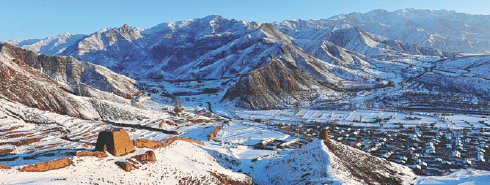Datong host to varied sections of Great Wall

Remnants of the Shoukoubao section of the Great Wall in the county of Yanggao. [Photo by Yang Jianmin for China Daily]
Shanxi is nicknamed "the Great Wall Museum" as it is said to be home to the longest stretch of the iconic structure built throughout a 2,000-year period.
The northern Shanxi city of Datong is one of the best places in the province to see the ancient wonder featuring architectural characteristics of different periods.
The construction of the Great Wall is said to have begun in the Warring States Period (475-221 BC) and ended some 400 years ago during the Ming Dynasty (1368-1644).
Datong, standing at the border between the farming Han and the northern nomads in ancient China, is said to boast all the periodic sections of the Great Wall.
The city also features the largest density of Great Wall sections in Shanxi, as it is surrounded by the outer Great Wall in the north and the inner Great Wall in the south.
The outer Great Wall is more than 250 kilometers in length, spanning such counties and districts as Yanggao, Xinrong, Zuoyun, Youyu, Pinglu and Pianguan.
The inner Great Wall extends from Lingqiu county in the east and meets the outer Great Wall in Pianguan in the west.
Many visitors to and locals in Datong say the Great Wall is attractive because of its storied history and their emotional links with the greatest defense project of ancient China.
When touring the Deshengbao section of the Great Wall in Xinrong district, Xu Yaxin, a tourist from East China's Zhejiang province, said: "The Great Wall is a symbol of China. And it is in Datong that I fully understand its significance in history and culture as the city presents the richest forms of the wall and tells so many stories about its history in about 2,000 years."
"After touring the Great Wall sections and hearing so many stories from the locals, I've got to know that it has been witness to both conflicts and exchanges.
"In times of peace, the Great Wall passes were the venues of exchange between the Han people and nomads in the north.
"When wars took place, the wall was pinned with high hopes in the defense against invaders. And if the wall was captured by the enemies, it was always disastrous to the nation," Xu said.
To make the best use of the Great Wall as a source for tourism, the government of Datong has made great efforts to improve infrastructure, including a highway to link many sections.
"With this highway, tourists will be able to access as many Great Wall sites as possible to explore their hidden mysteries scattered in the mountains, river valleys and plains," said Li Zhiyao, a Great Wall researcher in the city of Youyu. "This will give a strong boost to rural tourism in Datong and help rural residents increase their incomes."
Peng Ke'er contributed to this story.


